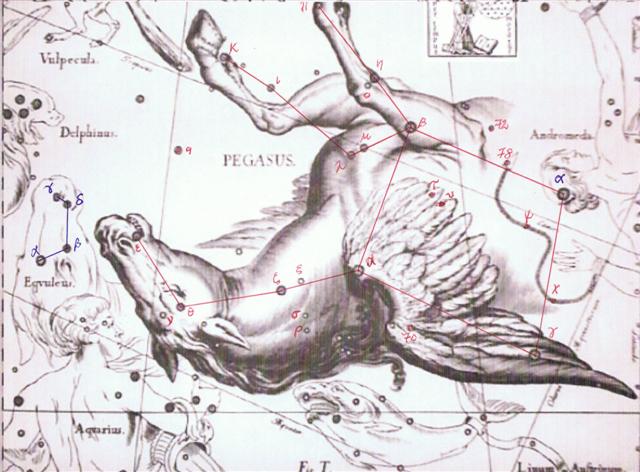Since Babylonian times, ca 3-4,000 years ago, Horse, Field, Stag, and Rainbow must have moved ahead in the solar year. Supposing the point in time where the head of the Horse confronted the head of the Stag represented winter solstice, then we could count from a position somewhere in the middle of the Field: ... the people knew that he was in possession of fire, and the stag determined to steal it for them. He took resinous wood, split it and stuck the splinters in his hair. Then he lashed two boats together, covered them with planks, danced and sang on them ... The Square of Pegasus could be imagined as a raft sailing upon the watery part of the sky. From winter solstice (December 21, 355) to Kerb (τ Pegasi) - which in rongorongo times happened to be in RA day 354 (= 12 * 29½) - there were 80 + 354 - 355 = 79 days.
To ψ Pegasi (also inside the Square but closer to Andromeda) there were 80 + 363 - 355 = 88 days. But 88 * 71 = 6248 is much too large a number to suit the Stag at December 21. We would instead need a number between 3,000 / 71 = 42 and 4,000 / 71 = 56. If we should count with a time depth of 50 * 71 = 3550 years earlier than ca 1870 A.D., then the Stag could have been moved by the precession from an initial position around 50 days earlier than 80 + 363 (ψ Pegasi) = 443 = 365 + 78 (March 19), i.e. from around 80 + 313 = 393 = 365 + 28 (January 28) to March 19 (78). Possibly, therefore, the head of the Stag could have been positioned at the end of January and 50 days earlier than the March equinox. The fiery antlers of the Stag cannot have been connected with the December solstice, instead the time ought to have been spring equinox: ... The stag landed and drew near the door, singing and dancing, and at the same time sprang to the door and made as if he wanted to enter the house. Then the door snapped to, without however touching him. But while it was again opening, he sprang quickly into the house. Here he seated himself at the fire, as if he wanted to dry himself, and continued singing. At the same time he let his head bend forward over the fire, so that he became quite sooty, and at last the splinters in his hair took fire. Then he sprang out, ran off and brought the fire to the people. However, the constellation Stag was not only a head but may have displayed his whole person (following his head):
...
The Panther, Nergal (Most of Cygnus & probably part of Cepheus)
The 'front legs of Pegasus & Lacerta' was the Horse, it is stated, and I discover that my star list needs the zigzag (kava) formation of Lacerta, a constellation created by Heverlius, and located directly below δ Cephei (Alrediph):
I have no explanation for the thought-provoking numbers added in my astronomy book to the normal Greek letters (by Bayer) or Latin numbers (by Flamsteed). HD refers to the Henry Draper Catalogue.
In RA day 341 (Saad Al Thabib 15) the last part of the zigzag 'bolt of lightning' rose with the Sun. Also, in rongorongo times, Pollux was culminating at midnight. There are 392 glyphs on side a of the C tablet and 392 = 28 * 14. February 25 is day 56 in the Gregorian year and 56 = 4 * 14. Therefore there are 364 = 24 * 14 days remaining from Ca12-26. 392 (side a) + 348 (side b) = 740 and 740 - 341 (niu in Ca12-25) = 399 = the synodic cycle of Jupiter. 341 = 11 * 31.
| |||||||||||||||||||||||||||||||||||||||||||||||||||||||||||||||||||||||||||||||||||||||||||||||||||||||||||||||||||||||||||||||||||||||||||||||||||||||||||||||||||||







